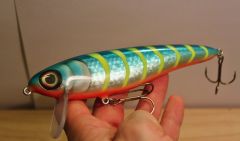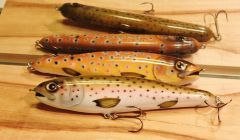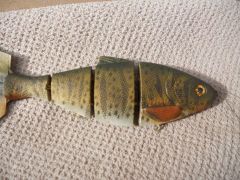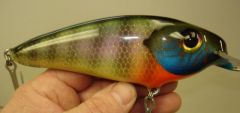
jkustel
TU Member-
Posts
76 -
Joined
-
Last visited
Content Type
Profiles
Articles
TU Classifieds
Glossary
Website Links
Forums
Gallery
Store
Everything posted by jkustel
-
The numbers such as 3lb, 10lb, etc. indicate how much a cubic foot weighs which is a measure of its density. The lower the density the more expansion occurs (allowing it to capture more air when it cures). This material shows good promise in terms of its density when trying to mimic light weight woods as well the strength is very impressive and increases with higher densities such as the 16lb and 25lb. So why aren't more folks using this stuff? It is much more difficult to pull off clean castings using silicone molds due to the expansion. Even with large vents in your mold the pressure it exerts even when compensating for the expansion is troublesome-it is very difficult to avoid distortions and material pushing into the mold half parting lines and seperating the halves. Has the headache started yet?. Also the finished casting seems to have more voids and defects than urethane and at the least will require quite a bit more clean up such as filler to prep it for paint. Which brings yet another issue. Getting paint to adhere to it is much more difficult as well. There are methods of pre-priming the molds that I was only able to get a fair result from. To sum up my experience. If your super motivated to use this material you had better be prepared to invest some serious time and effort to master it as it is much different than working with urethane resin. It certainly can be done but you have to basically make a study of how to deal with the expansion, achieving a nice skin to minimize paint prep, and getting good paint adhesion. If your making simple designs like big spooks or ms slammer type wake baits it might be fine. If your attempting more detailed casting with scales, fins, etcs...its going to be much more challenging to deal with. Also, the expansion is affected by things like temperature and humidity so keeping your densities consistent might not be as predictable as the number on the label. Personally, with all the additional issues over urethane resins I opted to look at other ways to make the urethane resin lighter where need be. Larger swimbaits in general don't often perform optimally with the densities of light woods such as basswood or cedar. If your looking for more buoyancy you don't necessarily need a lighter material you might instead add more volume to your design (make it fatter). In other words, instead of fighting your material...re-engineer the shape to work with the material your using. Urethane resin is a DREAM to work with next to urethane foam but if your super motivated you could possibly discover new ways of taming the beast that others haven't. Good luck. J
-
Hello gents, Not a lot of experience pouring soft plastics pretty much just been pouring tails for a line of hard swimbaits I've been selling. I have one particular bait that requires the tail to be relatively stiff (hold its shape and only flex slightly with the pressure of the water as the lure turns left and right). My question is whether its possible or feasible to take a saltwater formula plastisol and add additional hardener to achieve a stiffness comparable to a high duro silicone (50-60 shore a hardness)? Like I said, I'm looking for something that will only flex with pressure applied to it and rebound to its original shape once the pressures relieved. I would prefer to accomplish this task with plastisol over more expensive/long cure time silicone or urethane rubber. Also prefer all the coloring options of the plastisol. Thanks in advance for any insights. John
-
Thats a cool concept and execution. Fun to get things working on somewhat of a "razors edge" like that with the two weight placements somewhat competing with each other. Excellent original thinking. J
-
You definitely need to use any opened urethane relatively quick or it goes bad. If its fresh you can pour in high humidity and and still get away with it. As mentioned you can just use the 300 or any other unfilled resn and mix in your own mb's and meter your own ratio of mb's and have more control and versatility than using featherlite. Like that bass carving...: ) JK
-
Been building primarily with a urethane/silicone mold system for production baits but would like to start adding some wood baits to my line. Built a lot of baits in the past from poplar and even douglas fur stock but never the "holy grail" alaskan yellow cedar. (Nootka cypress) Been running a ton of searches and haven't been able to secure any sources. Read some blurbs that the Japanese are buying this stuff up. Don't know if there's any truth to it but it seems awfully tough to find. Thinking of using basswood or western red cedar if necessary but really want to at least test this wood before I get too deep into designs. I've noticed wake baits in particular from other builders made from this wood are nothing short of phenomenal in terms of action and put off a really nice knock. Thanks for any input. John Killer Instinct Swimbaits
-
Hey guys, Looking at the stainless steel bulk wire used to make spinnerbait forms,etc. Can someone comment on whether the .062 diameter would be sufficient as hinge pins in joints on large swimbaits? I'm seeing vague ratings at 460lbs breaking strength? That seems like it would be sufficient but will the flex cause it to bend. Any comments or suggestions appreciated. JK
-
I hear ya. I'm going to try to get the sections to fill just using small vents and see how it goes. I really don't want to be limited by space (in the pressure pot) on how many molds I can run and/or certainly don't want to have to recalculate all my densities based around another variable like air pressure.....yikes...thanks for the response.....hadn't thought of the density issue. JK
-
I know some guys get real overbearing about safety issues but I'm just stating that urethane plastic is ....well...urethane plastic. I like that the smooth on seems to produce consistent and strong castings. Honestly, I think these companies probably are sourcing through the same manufacturers of the raw chemicals these resins are made of. I've never felt any ill effects working around the urethane resin but I'm usually in my garage with the door at least part way up to provide some ventilation. I thought that the smooth on feather lite was terrible and didn't store well but since I switched to the smooth on smooth cast and added my own MB's (alumilites to be exact) everything has become consistent and predictable. I think alumilite works just fine too. I think starting with an unfilled urethane is best. Next time I may try RPN 40 as I've heard good things and the price is right. I do however always wear a respirator and keep exhaust fans going when I'm running auto clear-that stuff is no joke but the urethane shouldn't be taken too lighty. Good luck. JK
-
I have used both and I would think they are chemically the same in most respects. I woudn't pour urethane resin inside your house regardless of the brand. I really llike the performance of the smooth cast. JK
-
Curious who if anyone on here is using a pressure pot to cure their urethane while in the molds. I suppose if you don't have a lot of thin sections or details in your bait then the advantage is a more solid blank that has less bubbles. I'm considering some designs with thin fin sections, etc. and it sounds like curing them under pressure is the way to go to consistently get all the small channels to fill consistently. I hear of guys running anywhere from 30 to 80 lbs of pressure. The other key as I understand it is that your rtv molds must be cured under pressure as well or they will not withstand the pressure and distort, which makes sense. Thanks JK
-
I have a batch of lures I plan to repaint. Just got setup with some soft plastic paint. I attempted to remove the paint from one of the lures with laquer thinner and while it seemed to break the paint down ok it also seemed to chemically affect the plastic underneath?!? Anyone know of a good solvent to get the paint off without attacking the lure itself? I was considering trying some acetone. Any help is appreciated. Thanks. JK
-
Its made from a japanese cypress. I imagine it to be a fairly dense wood perhaps similar to maple or oak. If you try to make a bait that large out of a light wood like poplar your going to have to put a TON of lead in it to get it to sink. Mahogany might work well too. The key is weighting and getting the joint setup right. Good luck. JK
-
Hey guys, Considering options before I start pouring some softbaits. I would really like the option of doing actual paint jobs i.e. Huddleston. I noticed the sources for "plastic" paints is really limited as are the color options. Perhaps there's souces I couldn't find. I'm wondering if its possible to paint with normal airbrush paints and then come over the top with the plastic clear to lock it in? Any feedback is appreciated. JK
-
-
I was looking through the literature that came with my newest batch of resin I just picked up. It stated that the only way paint would adhere effectively to the resin castings after hitting the mold with mold release is to spray the primer coat right in the mold. I did pull some of my older resin baits and did see some areas that looked a little suspect. I normally just wash the baits with soap and water and let them post cure before painting. Anyone address this issue?? JK
-
Prepping to give some mold making another run. One area I fell way short last time was not storing my urethane plastic properly. Funny how the most basic things creep in and ruin our plans. My resin source said once the containers are open to use something like bloxgen to create a barrier in the container from moisture and air. (Sound familiar?) I noticed Larry Dahlberg was using a dispenser pump in one of his videos and I'm thinking that would be a pretty cool solution and a lot cleaner. Of course I wonder if the pump valve will keep moisture out....apparently it works for Larry. I'm going to be using a resin with a pretty short pot life so dispensing a few ounces at a time will be the way to go to stay ahead of the cure time. Seems like a clean tidy solution. Thoughts? JK
-
-
-
Auto clear in a can (as mentioned) or through a gun. Protect your lungs. JK
-
Based on the number of punkers I've repainted for guys, I'm not sure they're using anything great for a topcoat. I agree if its not Devcon 2 ton I'd be surprised....it definitely comes apart like shards of glass...very brittle. When I redo them I use 2-3 coats of e-tex and it seems to be outperforming their one coat of devcon. I would apply at least two coats of e-tex and wait for it to setup a little bit before applying it. I absolutely agree though with Gunnie, jointed lures are best handled being sprayed with auto clear. You'll need to get setup for it...its nasty stuff to breath but thats another topic. Search the threads on auto clear and you'll be up to speed. Ahhh clear coats....You'll get wear in the joints...its just the way it goes. If your using wood make sure your sealing the wood well. JK
-
I think the v-cut joint works fine. Its by far the most used on large swimbaits. I personally don't think it has a dramatic effect on the action. I think it just looks more slealth. I personally think things like how wide the gap is and the size of the screw eyes have more impact on the action that the actual shape of the joint. Tons of proven swimbaits using that basic v-joint though...AC Plugs, MS Slammers, Triple Trouts, BBZ-1, Ragos baits, etc....its everywhere for a reason. J My 2 cents. JK
-
-
Good observations. Thanks for correcting my thinking on the solids versus fluid...now that make sense. Fortunately I'm in so cal and we have a pretty temperate mild climate for the most part with low humidity most of the time. I think I'm going to give it a go again and do two things to help control the density issues: 1.) Work with smaller batches of resin and use the entire batch in a single session to control the settling issues. I mixed pretty well before but apparently I had some storage issues that were affecting the consistency of the resin. 2.) Make the pours in relatively dry cool periods at night in 60-70 degree temps. Time to go make some masters and start building some molds....ahhhh fun. Thanks much guys. JK
-
I should qualify my results more carefully. I noticed that as I started using a fresh batch of featherlite the consistency was good. I would think I had it nailed then go back a few days later and the weights would start moving....the closer I got to the end of the batch the baits were lighter by a full half ounce and varied a lot more widely from bait to bait but getting progressively lighter. That makes no sense to me because I would think if anything the heavier parts would settle and possible make the mix slightly heavier. It also seemed like a change of 10 degrees in ambient temperature caused more expansion and thus produced lighter baits. Just seemed like I was fighting a losing battle with factors largely out of my control. Quality of the resin changing and the temperature. Of course, it haunts me knowing plenty of guys are doing it and with all the benefits. That tells me its possible....does it swim as good as wood?....hahahahhah...should be fine on the heavier baits. Light baits like topwaters and wakebaits I'm still a big believer in the raw buoyancy and sound of wood. JK
-
I use two piece molds and they "breathe" pretty well. I could tell the heavy baits from the light baits. The heavy baits would push out a little material before setting up.....the light ones would mushroom out everywhere. I haven't read too many glowing reviews about the featherlite so perhaps I'll give it a go with the alumilite plus micros and keep my pours in cooler weather or at night. Keep em' coming.... JK






